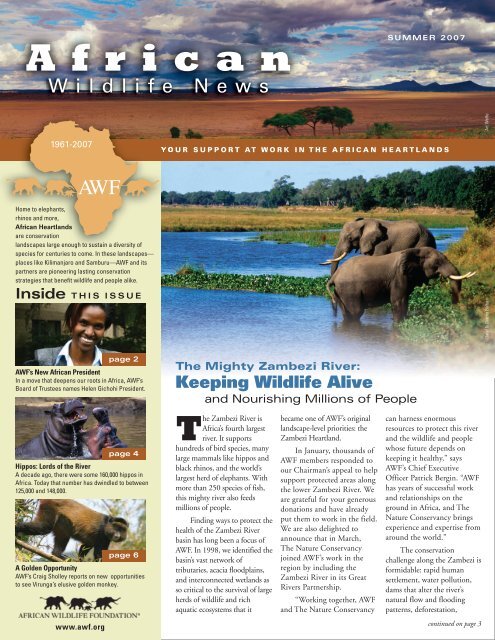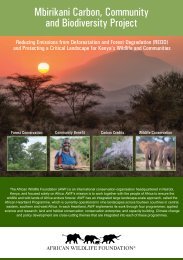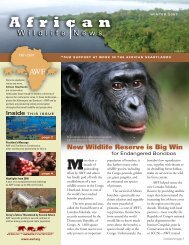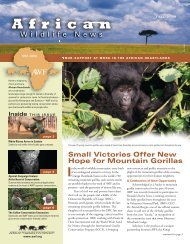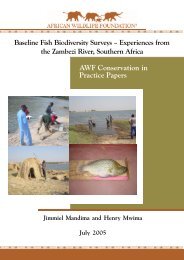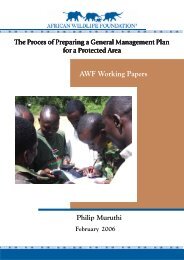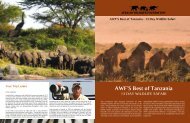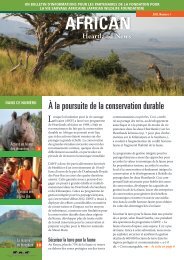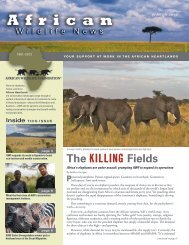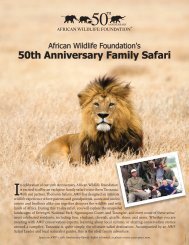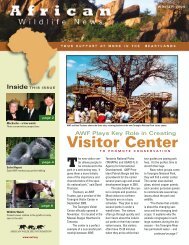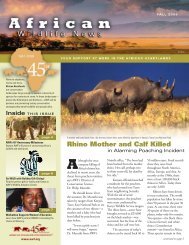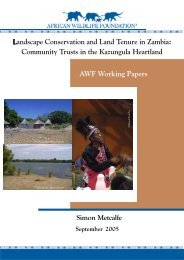Zambezi: Keeping Wildlife Alive - African Wildlife Foundation
Zambezi: Keeping Wildlife Alive - African Wildlife Foundation
Zambezi: Keeping Wildlife Alive - African Wildlife Foundation
Create successful ePaper yourself
Turn your PDF publications into a flip-book with our unique Google optimized e-Paper software.
SUMMER 2007<br />
1961-2007<br />
AWF<br />
Home to elephants,<br />
rhinos and more,<br />
<strong>African</strong> Heartlands<br />
are conservation<br />
landscapes large enough to sustain a diversity of<br />
species for centuries to come. In these landscapes—<br />
places like Kilimanjaro and Samburu—AWF and its<br />
partners are pioneering lasting conservation<br />
strategies that benefit wildlife and people alike.<br />
Inside THIS ISSUE<br />
Daryl & Sharna Balfour Art Wolfe<br />
page 2<br />
AWF’s New <strong>African</strong> President<br />
In a move that deepens our roots in Africa, AWF’s<br />
Board of Trustees names Helen Gichohi President.<br />
The Mighty <strong>Zambezi</strong> River:<br />
<strong>Keeping</strong> <strong>Wildlife</strong> <strong>Alive</strong><br />
and Nourishing Millions of People<br />
page 4<br />
Hippos: Lords of the River<br />
A decade ago, there were some 160,000 hippos in<br />
Africa. Today that number has dwindled to between<br />
125,000 and 148,000.<br />
page 6<br />
A Golden Opportunity<br />
AWF’s Craig Sholley reports on new opportunities<br />
to see Virunga’s elusive golden monkey.<br />
The <strong>Zambezi</strong> River is<br />
Africa’s fourth largest<br />
river. It supports<br />
hundreds of bird species, many<br />
large mammals like hippos and<br />
black rhinos, and the world’s<br />
largest herd of elephants. With<br />
more than 250 species of fish,<br />
this mighty river also feeds<br />
millions of people.<br />
Finding ways to protect the<br />
health of the <strong>Zambezi</strong> River<br />
basin has long been a focus of<br />
AWF. In 1998, we identified the<br />
basin’s vast network of<br />
tributaries, acacia floodplains,<br />
and interconnected wetlands as<br />
so critical to the survival of large<br />
herds of wildlife and rich<br />
aquatic ecosystems that it<br />
became one of AWF’s original<br />
landscape-level priorities: the<br />
<strong>Zambezi</strong> Heartland.<br />
In January, thousands of<br />
AWF members responded to<br />
our Chairman’s appeal to help<br />
support protected areas along<br />
the lower <strong>Zambezi</strong> River. We<br />
are grateful for your generous<br />
donations and have already<br />
put them to work in the field.<br />
We are also delighted to<br />
announce that in March,<br />
The Nature Conservancy<br />
joined AWF’s work in the<br />
region by including the<br />
<strong>Zambezi</strong> River in its Great<br />
Rivers Partnership.<br />
“Working together, AWF<br />
and The Nature Conservancy<br />
can harness enormous<br />
resources to protect this river<br />
and the wildlife and people<br />
whose future depends on<br />
keeping it healthy,” says<br />
AWF’s Chief Executive<br />
Officer Patrick Bergin. “AWF<br />
has years of successful work<br />
and relationships on the<br />
ground in Africa, and The<br />
Nature Conservancy brings<br />
experience and expertise from<br />
around the world.”<br />
The conservation<br />
challenge along the <strong>Zambezi</strong> is<br />
formidable: rapid human<br />
settlement, water pollution,<br />
dams that alter the river’s<br />
natural flow and flooding<br />
patterns, deforestation,<br />
www.awf.org<br />
continued on page 3
2 <strong>African</strong> <strong>Wildlife</strong> News www.awf.org<br />
Machache ~ A FEW WORDS<br />
BOARD OF TRUSTEES<br />
Dennis J. Keller<br />
chair<br />
Matthew T. Weir<br />
vice chair<br />
Wariara Mbugua<br />
secretary<br />
Crandall C. Bowles<br />
treasurer<br />
Edward M. Armfield, Jr.<br />
Robin Berkeley<br />
Wendy McCrary Breck<br />
Jacques J. Busquet<br />
Paul Campbell<br />
Stephen D. Cashin<br />
Dale F. (Tucker) Dorn<br />
Paul Fletcher<br />
James L. Foght, Ph.D.<br />
Donald C. Graham<br />
Christine F. Hemrick<br />
William E. (Wilber) James<br />
Dr. William Kalema<br />
Walter H. Kansteiner, III<br />
Dorothy Kim<br />
Robert E. King<br />
Mark D. Kvamme<br />
Shana Laursen<br />
Victoria Leslie<br />
James F. Makawa<br />
Sir Ketumile Masire<br />
Benjamin W. Mkapa<br />
Eleanor G. Nalle<br />
Kristina Persson<br />
Dr. Mamphela A. Ramphele<br />
Tia N. Roddy<br />
Lisa M. Stevens<br />
David Thomson<br />
C. Bowdoin Train<br />
John R. Walter<br />
Richard W. Weening<br />
trustees emeriti<br />
Arthur W. Arundel<br />
E.U. Curtis Bohlen<br />
David Challinor, Ph.D.<br />
Joan Donner<br />
John H. Heminway<br />
George C. Hixon<br />
Richard M. Jackson<br />
Henry P. McIntosh, IV<br />
Sally Pingree<br />
Stuart T. Saunders, Jr.<br />
Russell E. Train<br />
<strong>African</strong> <strong>Wildlife</strong> News<br />
is published four times a year.<br />
communications officer<br />
Paul Thomson<br />
©2007 <strong>African</strong> <strong>Wildlife</strong> <strong>Foundation</strong><br />
1400 16th Street, N.W., Suite 120<br />
Washington, D.C. 20036<br />
202-939-3333<br />
202-939-3332 (fax)<br />
1-888-494-5354<br />
E-mail: awn@awf.org<br />
Website: www.awf.org<br />
CFC# 11219<br />
Printed with soy-based ink<br />
Recycled Paper<br />
AWF’s New<br />
<strong>African</strong><br />
President<br />
One of the pillars<br />
of the <strong>African</strong><br />
<strong>Wildlife</strong><br />
<strong>Foundation</strong>’s success in<br />
Africa is the belief that<br />
visionary conservation<br />
leadership must emanate<br />
from Africa itself. I am<br />
pleased to announce that<br />
AWF’s Board of Trustees<br />
recently recognized such a<br />
visionary by naming our<br />
own Dr. Helen Gichohi as<br />
President of AWF. This<br />
bold move deepens our<br />
roots in Africa. It is an<br />
evolution in AWF’s<br />
leadership that I have long<br />
worked for, and it will be<br />
my pleasure to continue to<br />
serve as AWF’s Chief<br />
Executive Officer.<br />
It is visionary <strong>African</strong><br />
conservationists like Helen,<br />
buttressed by support from<br />
people and organizations<br />
throughout the world<br />
with an appreciation of<br />
the unparalleled assets of<br />
Africa’s wildlife and wild<br />
lands, who will ensure that<br />
<strong>African</strong> conservation<br />
prospers Africa’s people as<br />
it perpetuates Africa’s<br />
unique species and<br />
splendid landscapes.<br />
A Kenyan national,<br />
Helen holds a Ph.D. in<br />
ecology and has been<br />
working in conservation for<br />
more than 15 years. Prior to<br />
joining AWF in 2000, she<br />
worked with the <strong>African</strong><br />
Conservation Center and<br />
the <strong>Wildlife</strong> Conservation<br />
Society. In 1998, Helen was<br />
selected as one of five<br />
<strong>African</strong>s who briefed<br />
President Bill Clinton on<br />
Africa’s environmental<br />
issues. For the past five<br />
years, Helen has served as<br />
AWF’s Vice President for<br />
Program, a role requiring<br />
outstanding technical<br />
knowledge, vision, passion,<br />
and managerial savvy. Her<br />
training, experience, and<br />
outstanding personal<br />
attributes make Helen the<br />
ideal first <strong>African</strong> president<br />
of AWF.<br />
“For conservation to<br />
succeed in Africa, it<br />
must be of, by, and<br />
for its people.”<br />
For conservation to<br />
succeed in Africa, it must<br />
be of, by and for its people.<br />
That belief is at the heart<br />
of AWF, one that makes us<br />
virtually unique among<br />
international conservation<br />
organizations. Since our<br />
founding in 1961, we have<br />
helped thousands of<br />
<strong>African</strong> citizens receive<br />
higher education as park<br />
wardens, wildlife managers<br />
and scientists.<br />
When we established<br />
the <strong>African</strong> Heartlands<br />
program as our overarching<br />
wildlife and landscape<br />
conservation strategy in<br />
1998, we stretched the<br />
envelope of conservation<br />
theory and practice. While<br />
traditional protected areas<br />
remained at the core of<br />
these Heartlands, we<br />
recognized a clear need to<br />
engage diverse private<br />
citizens, tribal landholders,<br />
local governments, and<br />
others to protect habitats<br />
large enough for wildlife to<br />
disperse, migrate,<br />
propagate, and thrive. This<br />
is not something that can<br />
be imposed on people, but<br />
must grow through<br />
engagement with them.<br />
AWF is perfectly<br />
positioned to meet this<br />
challenge. More than 85<br />
percent of our staff is<br />
<strong>African</strong>. When they speak<br />
about working with ‘local<br />
communities,’ they are not<br />
referring to a theoretical<br />
concept. They are referring<br />
in many cases to their own<br />
aunts, uncles and cousins.<br />
Helen’s new<br />
appointment extends<br />
AWF’s commitment to the<br />
people of Africa as the first,<br />
most important leaders for<br />
conservation. With your<br />
steadfast support, we will<br />
continue to break the mold<br />
as we help define the future<br />
of conservation in Africa.<br />
Dr. Patrick Bergin<br />
AWF Chief Executive Officer<br />
AWF/Paul Thomson
Cardo Kleberg<br />
www.awf.org <strong>African</strong> <strong>Wildlife</strong> News 3<br />
<strong>Zambezi</strong>: <strong>Keeping</strong><br />
<strong>Wildlife</strong> <strong>Alive</strong><br />
continued from page 1<br />
incompatible agriculture, and<br />
unsustainable fishing are all taking a toll.<br />
“Maintaining the <strong>Zambezi</strong>’s role as a<br />
functional lifeline from an ecological and<br />
AWF and The Nature Conservancy are working with<br />
communities in the <strong>Zambezi</strong> Heartland who depend on<br />
the <strong>Zambezi</strong> River for fish, agriculture, and fresh water.<br />
economic standpoint is the overall vision<br />
for this initiative,” says Jimmiel Mandima,<br />
Director for AWF’s <strong>Zambezi</strong> Heartland.<br />
As part of this cooperative venture,<br />
AWF and The Nature Conservancy will<br />
work with government authorities and<br />
other key stakeholders on a basin-wide<br />
assessment that identifies critical ecosystems<br />
and the major threats to them. AWF has<br />
long understood that the only lasting<br />
conservation solutions are those that<br />
include <strong>African</strong> communities who have the<br />
most at stake.<br />
“Rivers must maintain their natural<br />
ability to provide clean water, convey<br />
floodwaters and vary their flow seasonally,”<br />
says Michael Reuter, Director of the<br />
Conservancy’s Great Rivers Partnership.<br />
“Healthy rivers support all life.”<br />
With your steadfast support, the<br />
<strong>Zambezi</strong> River will continue to nourish the<br />
wildlife and local communities whose<br />
survival depends on it. ■<br />
To learn more about AWF’s <strong>Zambezi</strong><br />
Heartland, or make a donation to help, visit<br />
AWF’s website at www.awf.org/zambezi<br />
News in Brief<br />
Tarangire Lion<br />
Project Roars Ahead<br />
TANZANIA—If they stay within the<br />
confines of the park—which they do for<br />
most of the dry season—the lions of<br />
Tarangire National Park stay fairly safe.<br />
To survive however, the lions must follow<br />
prey species which tend to migrate<br />
outside the park during the long rainy<br />
season. As the lions disperse onto<br />
surrounding communal lands, they<br />
frequently come into contact with their<br />
human neighbors and their livestock.<br />
And in some cases, when lions take<br />
livestock, people retaliate by killing lions.<br />
Bernard Kissui<br />
Mighty River of Southern Africa<br />
• The <strong>Zambezi</strong> is Africa’s fourth largest<br />
river system, after the Nile, Congo, and<br />
Niger rivers.<br />
• This mighty river flows for 1,500 miles<br />
through Zambia, Angola, Namibia,<br />
Botswana, Zimbabwe, and<br />
Mozambique on its journey from<br />
central Africa to the Indian Ocean.<br />
• The awesome power of the <strong>Zambezi</strong><br />
carved spectacular Victoria Falls<br />
(pictured), one of the seven natural<br />
wonders of the world.<br />
• The <strong>Zambezi</strong> basin supports more<br />
than 250 species of fish that are vital<br />
to the ecosystem. Millions of people<br />
in the region rely on the river’s fish,<br />
including tigerfish and Vundu catfish,<br />
for sustenance.<br />
• Hundreds of bird species reside within<br />
the <strong>Zambezi</strong> basin, including the<br />
snake eagle, Marabou stork, and<br />
<strong>African</strong> fish eagle.<br />
• The <strong>Zambezi</strong> and its tributaries<br />
provide habitat for many mammals,<br />
including lions, zebras, hippos, buffalo,<br />
black rhinos—and the world’s largest<br />
herd of elephants.<br />
• Rapid human settlement, water<br />
pollution, dams that alter the river’s<br />
natural flow, deforestation,<br />
incompatible agriculture, and<br />
unsustainable fishing are all taking a<br />
toll on the <strong>Zambezi</strong>’s ecological health.<br />
Daryl & Sharna Balfour<br />
AWF lion researcher Bernard Kissui<br />
is discovering that if human-lion clashes<br />
continue, Tarangire’s lion population<br />
could be wiped out.<br />
Figuring out how to reduce conflicts<br />
between lions and people is the next goal<br />
for this project. Bernard’s research team<br />
is testing lion-proof livestock enclosures<br />
at key pilot sites. They use radio collars<br />
to track lions (see photo) and map areas<br />
outside the park that are most frequently<br />
used by lions so livestock owners can<br />
avoid them.<br />
Much work remains to be done in<br />
this multi-year project, but Bernard’s<br />
research will ultimately help in the<br />
development of village land-use plans<br />
that reduce threats to Tarangire’s lions—<br />
and protect the livelihoods of<br />
surrounding communities, too. ■
4 <strong>African</strong> <strong>Wildlife</strong> News www.awf.org<br />
FOCUS ON SPECIES—HIPPOS: LORD<br />
Craig R. Sholley<br />
Ask a child to describe a hippopotamus and<br />
you’re likely to get a picture of a friendly,<br />
mild-mannered beast wallowing in a river or<br />
even dancing merrily in a tutu à la Disney’s Fantasia.<br />
Indeed, the hippopotamus’ sedentary lifestyle and<br />
roly-poly figure factor heavily in its popular image as<br />
one of the quieter, gentler <strong>African</strong> mammals.<br />
Mark Boulton/ICCE<br />
The reality—as anyone who has<br />
encountered one in the wild knows—is<br />
that the hippopotamus is a force to be<br />
reckoned with, the lord of <strong>African</strong><br />
waterways. Uniquely adapted to its<br />
environment, larger and stronger than most<br />
animals around it, the hippo is neither<br />
quiet, nor gentle, nor necessarily benign.<br />
According to local <strong>African</strong> lore, hippos kill<br />
more humans each year than lions,<br />
elephants, leopards and rhinos combined.<br />
But as much as hippos pose a threat to<br />
people, people pose a threat to hippos.<br />
Though lions and crocodiles prey on<br />
hippos, humans are the predators driving<br />
hippos to the brink of extinction in parts<br />
of Africa.<br />
Hippos Yesterday and Today<br />
The name hippopotamus comes from<br />
the Greek hippos (horse) and potamos<br />
(river), but this gigantic beast is not actually<br />
related to its namesake. In fact, the hippo’s<br />
closest living relatives are whales and<br />
porpoises. Biologically, hippos have more in<br />
common with whales than they do with<br />
other even-toed ungulates, such as pigs.<br />
The hippopotamus (Hippopotamus<br />
amphibius) was once common in most of<br />
Africa except the Sahara. Today it is found<br />
only in sub-Saharan countries, including<br />
Botswana, Democratic Republic of Congo,<br />
Kenya, South Africa, Uganda, Zambia,<br />
and Zimbabwe.<br />
A decade ago, there were about<br />
160,000 hippos in Africa, but the<br />
population has now dwindled to<br />
between 125,000 and 148,000. Much of<br />
this loss is attributed to the dramatic<br />
decline of the hippo population in the<br />
Democratic Republic of Congo (DRC).<br />
The country's turbulent political<br />
situation has allowed unregulated<br />
hunting for hippo meat and ivory,<br />
causing a 95 percent crash in its hippo<br />
numbers. Sadly, the hippo has now<br />
joined the ranks of species listed by the<br />
World Conservation Union (IUCN) as<br />
‘vulnerable,’ a designation that a species<br />
is ‘at high risk of extinction.’
www.awf.org <strong>African</strong> <strong>Wildlife</strong> News 5<br />
S OF THE RIVER<br />
The ‘Other’ Hippo<br />
There is another, much smaller<br />
species of hippo called the pygmy<br />
hippopotamus (Hexaprotodon liberiensis).<br />
Limited to very restricted ranges in West<br />
Africa, it is a shy, solitary forest dweller.<br />
The pygmy hippo’s status has recently<br />
been changed from ‘vulnerable’ to<br />
‘endangered,’ which means it is at ‘very<br />
high risk of extinction.’<br />
Perfect Adaptation: Head to Toe<br />
During daylight hours, hippos spend<br />
most of their time wallowing in shallow<br />
water. But this inactive lifestyle belies the<br />
true complexity of hippo behavior and<br />
biology. In fact, many of its characteristics<br />
demonstrate that it is extremely well<br />
adapted for its watery environment.<br />
With its eyes, ears and nostrils on the<br />
top of its head, the hippo can hear, see and<br />
breathe with most of its body underwater,<br />
keeping cool and sheltered from the<br />
tropical sun.<br />
The hippo’s webbed toes splay out to<br />
distribute the animal’s massive weight<br />
evenly and support it on land. Its feet also<br />
help it move through the water, as the<br />
hippo is unable to float or swim. It moves<br />
around by pushing off from the riverbed or<br />
simply pressing through the water in a<br />
slow-motion gallop, lightly touching the<br />
bottom with its toes.<br />
The hippopotamus—whose hide<br />
alone can weigh half a ton—is the thirdlargest<br />
living land mammal after elephants<br />
and white rhinos. Dominant males can<br />
weigh 6,000 pounds or more, while<br />
females and most other males weigh<br />
between 3,500 and 4,500 pounds. They<br />
can live for 50 years.<br />
Despite their weight, hippos are<br />
surprisingly agile and often cross steep<br />
banks each night to graze on grass. They<br />
always enter and exit water at the same<br />
spots and graze for four to five hours,<br />
covering one or two miles, with extended<br />
forays of up to five miles.<br />
Though hippos occasionally battle<br />
with crocodiles, more and more conflicts<br />
are with humans. Capable of sprinting<br />
faster than a person, hippos are fierce and<br />
deadly when threatened.<br />
Helping Hippos Survive<br />
Because hippos live in fresh water,<br />
they stand directly between people and<br />
one of the most limited resources in<br />
Africa. As agricultural development has<br />
increased, the wetland, river and lake<br />
habitats of hippos have been depleted. As<br />
a result, hippos often raid waterside farms<br />
for crops, increasing the risk of clashing<br />
with people. Hundreds are shot each year<br />
in “controlled management” schemes in<br />
populated areas, despite the fact that they<br />
are easily deterred by ditches or low<br />
fences. Others are poached.<br />
As dangers to hippos grow, the<br />
conservation challenge grows more<br />
complex. The key to ensuring their future<br />
lies in an integrated approach to<br />
conservation that looks not only at the<br />
species itself, but at the needs of local<br />
communities, land use, and the ecosystem<br />
as a whole.<br />
In the Democratic Republic of<br />
Congo, AWF efforts will ultimately benefit<br />
hippos and all the wildlife of the region.<br />
We have underwritten a shipping project<br />
on the Congo and Maringa Rivers to bring<br />
agricultural products to market. As the<br />
project’s cargo boat makes its way up and<br />
down the waterways, it brings farmers’<br />
goods to market for the first time in years.<br />
In time, the return of river transport will<br />
Hippos as Targets<br />
In countries beset by civil unrest,<br />
where food supplies for humans are<br />
severely limited, hippos are poached for<br />
their meat. Some are also killed for their<br />
tusk-like teeth, which can grow up to a<br />
foot or longer and which, unlike elephant<br />
tusks, do not yellow with age.<br />
Habitat destruction and human<br />
suffering caused by recent warfare in the<br />
help farmers re-establish their livelihoods,<br />
while reducing the destruction of local<br />
forests and wildlife. Meanwhile, along the<br />
lower <strong>Zambezi</strong> River—another area where<br />
hippos abound—AWF is working with the<br />
Zambia <strong>Wildlife</strong> Authority to pump life<br />
back into Lower <strong>Zambezi</strong> National Park.<br />
The park’s lack of crucial resources<br />
hampers its efforts to protect the region’s<br />
wildlife. AWF plans to help with vehicles,<br />
fuel, GPS tracking equipment, tents, and<br />
food rations for park patrols.<br />
Removing incentives for poaching,<br />
protecting habitats, and empowering local<br />
communities are key to securing a safe<br />
future for hippos in the wild. The success<br />
of each depends on your continued and<br />
generous support. ■<br />
Visit www.awf.org to learn more about hippos<br />
and AWF conservation projects that help them.<br />
Democratic Republic of the Congo (DRC)<br />
has caused a dramatic decline in the hippo<br />
population there. Numbers in DRC’s<br />
Virunga National Park dropped from<br />
29,000 in the 1970s to about 900, raising<br />
concerns about the survival of that<br />
population. Local militia groups, poorly<br />
paid Congolese soldiers, and others have<br />
been responsible for poaching the animals,<br />
probably for money and meat.<br />
Craig R. Sholley
6 <strong>African</strong> <strong>Wildlife</strong> News www.awf.org<br />
A Golden Opportunity<br />
by Craig Sholley<br />
Over the past several decades, thousands of people have<br />
traveled to Rwanda and Uganda to spend a magical<br />
hour in the presence of mountain gorillas on the slopes of<br />
central Africa’s majestic Virunga Mountains. Recently,<br />
however, I was treated to another Virunga adventure that<br />
both surprised and delighted me: tracking a troop of golden<br />
monkeys—a lovely primate found only in the bamboo forests<br />
of this misty volcanic chain.<br />
The golden monkey (Cercopithecus mitis kandti) weighs<br />
10 to 25 pounds and has a light russet-brown body, cheeks<br />
and tail with contrasting black limbs, crown and tail-end.<br />
Little is presently known about its ecological requirements,<br />
and its numbers have not yet been determined. Sharing the<br />
lofty montane forests of the Virungas with its great ape<br />
relatives, the golden monkey faces some of the same threats as<br />
mountain gorillas, including snares set for small antelopes and<br />
human encroachment on its habitat.<br />
Over the course of my work with mountain gorillas, I had<br />
seen this elusive primate, but most encounters were fleeting<br />
flashes of gold as the monkeys acrobatically propelled<br />
themselves from one stand of bamboo to another and then<br />
quickly disappeared. Given past encounters, I was skeptical<br />
when I heard that several troops of golden monkeys had been<br />
‘habituated’ in Rwanda’s Volcanoes National Park, and I kept<br />
my expectations in check.<br />
Arriving at Volcanoes National Park headquarters early<br />
to meet our guide, we had a brief orientation about forest and<br />
monkey ‘etiquette.’ Then we drove over rough roads to a wellworn<br />
path. Entering dense stands of bamboo interspersed<br />
with open glades, we hiked at 9,000 feet on narrow trails for<br />
about 45 minutes. Sounds of movement ahead of us halted<br />
our guide, and he turned to inform us that we would be<br />
spending one hour with the monkeys and our time started<br />
now. I was pleased to learn that strict guidelines similar to<br />
those adopted for viewing gorillas are being used for golden<br />
monkey visits.<br />
Our group moved forward quietly, in perfect position<br />
for a natural history extravaganza, but the wildlife ‘stars’<br />
were ‘no-shows.’ Just as my earlier skepticism began to<br />
return, a large male golden monkey confidently strode<br />
across a stalk of bamboo no more than 20 feet from me.<br />
Seemingly unfazed by the group’s presence, he perched in<br />
plain view and began feeding on bamboo leaves.<br />
We then watched in amazement as nearly 50 more<br />
monkeys crossed in front of us. The real show was about to<br />
begin. One of the females moved to a gap in the bamboo. A<br />
dozen feet or more of thin air separated her from the next<br />
clump. Contemplating the distance for about 30 seconds, she<br />
spring-boarded from her roost to the next stand. For the next<br />
half-hour, our group of elated onlookers watched as monkey<br />
after monkey made the leap. The hour passed, and all too<br />
soon it was time to depart.<br />
Two groups of golden monkeys have now been<br />
habituated. As a result, researchers are learning more about<br />
this little-known species and how best to protect it. Carefully<br />
timed visits allow tourists to observe another rare primate in<br />
its native habitat. And both bring economic and conservation<br />
benefits to the national park, the local community and, in the<br />
long term, the elusive golden monkey. ■<br />
Craig R. Sholley<br />
AWF’s Craig Sholley has lived in or been traveling to Africa for more than 30 years.<br />
A knowledgeable and engaging safari traveler, Craig leads AWF member safaris.<br />
Travel with AWF This Winter!<br />
December 3 – 14, 2007<br />
Are you ready to take the <strong>African</strong> safari of a lifetime<br />
AWF and Ker & Downey Safaris Ltd. are leading a<br />
spectacular <strong>African</strong> safari this December in Kenya. The<br />
safari showcases some of the country’s most spectacular<br />
wildlife viewing areas, and offers ‘behind-the-scenes’<br />
interactions with some of the country’s prominent<br />
conservationists and scientific researchers. ■<br />
For more information, please contact Craig Sholley at<br />
csholley@awf.org or call 1-202-939-3339.
www.awf.org <strong>African</strong> <strong>Wildlife</strong> News 7<br />
Avis Goodwin’s<br />
Legacy Lives On<br />
Her Bequest Continues to<br />
Safeguard the <strong>Wildlife</strong> She Loved<br />
When Avis Goodwin joined AWF in 1990, she was drawn to<br />
our work to safeguard elephants, lions and other large<br />
mammals. She was also deeply committed to AWF’s belief that the<br />
future of Africa’s wildlife lies in providing educational and<br />
professional opportunities for young <strong>African</strong> conservationists.<br />
“Avis served as my<br />
friend and mentor…<br />
emphasizing that<br />
education gives one<br />
the right to choose and<br />
think wisely…to make<br />
this earth a better<br />
place to live.”<br />
—AWF’s Josephine<br />
Simon<br />
The bequest Ms. Goodwin left<br />
to AWF when she died in 2003 has<br />
supported many important projects<br />
dear to her heart, including our<br />
elephant research in West<br />
Kilimanjaro, and lion monitoring<br />
studies in Kazungula.<br />
Ms. Goodwin’s legacy also lives<br />
on in the <strong>African</strong> women whose<br />
conservation careers she helped<br />
financed. Among them is Josephine<br />
Simon, an AWF Community Conservation Officer who works<br />
with Maasai women helping them manage, conserve, and benefit<br />
from their natural resources. After studying in the United States,<br />
Josephine returned to her native Tanzania in 1998, where she<br />
worked as an AWF intern. When her internship ended in 2000,<br />
Josephine received a scholarship from Ms. Goodwin to pursue her<br />
studies in environmental resource management.<br />
“Avis served as my friend and mentor,” says Josephine. “She<br />
encouraged my academic efforts, often emphasizing that education<br />
gives one the right to choose and think widely, that the knowledge<br />
received—if used properly—will make this earth a better place to live.”<br />
A resident of Santa Barbara, California, at the time of her death,<br />
Avis Goodwin was born in<br />
“Providing educational<br />
Maine. She held a master’s degree<br />
opportunities allows<br />
in psychology and counseling,<br />
<strong>African</strong>s to play critical<br />
worked in public schools in<br />
roles in achieving a<br />
California, became active in local,<br />
national, and international<br />
balance between using<br />
wildlife issues, and credited her and preserving their<br />
love of elephants to a trip to natural resources.”<br />
Africa that changed her life. —Avis Goodwin<br />
It was during an interview in 2003, however, that Ms. Goodwin<br />
elaborated on her interest in AWF’s education programs. “Education<br />
promotes freedom, and opens doors that otherwise would not exist,”<br />
said Ms. Goodwin. “Providing educational opportunities allows<br />
<strong>African</strong>s to play critical roles in achieving a balance between using and<br />
preserving their natural resources. Educating girls and young women<br />
is a critical part of this.”<br />
Through her vision, commitment, generosity, and far-sighted<br />
estate planning, Avis Goodwin’s legacy will continue to help the<br />
wildlife and people of Africa for many years to come. ■<br />
Looking for New<br />
Ways to Help<br />
Africa’s <strong>Wildlife</strong><br />
Your IRA May Be the Key—But<br />
You Must Act by December 31st<br />
If you're looking for a tax-effective way to increase your<br />
support to AWF’s wildlife conservation programs, your<br />
individual retirement account (IRA) may well be the best<br />
choice.<br />
The Pension Protection Act of 2006 presents a new giving<br />
opportunity—but the deadline for action is Dec. 31, 2007.<br />
The law allows individuals aged 70 or older to make gifts<br />
now to qualified charitable organizations like AWF using<br />
funds transferred directly from their IRAs. Furthermore, these<br />
individuals will not have to pay taxes on the amounts<br />
transferred. You can transfer any amount you desire up to<br />
$100,000 on or before Dec. 31, 2007.<br />
Benefits to You<br />
• The transfer counts toward your minimum required<br />
distribution as long as you have not yet received<br />
your 2007 distribution.<br />
• The transfer generates neither taxable income nor a<br />
tax deduction, so you will receive the benefit even if<br />
you do not itemize your tax deductions.<br />
• You can increase the conservation impact your<br />
philanthropic dollars provide for Africa’s wildlife.<br />
How the New Law Works<br />
Sandy, aged 73, has $150,000 in an IRA. She had been<br />
thinking of substantially increasing her annual contribution to<br />
AWF this year with a gift of $5,000 or more. She had the<br />
choice of giving cash or other assets. Now she has another<br />
option. If she transfers $5,000 to AWF from her IRA on or<br />
before Dec. 31, 2007, she can avoid paying income tax on<br />
$5,000—a huge benefit, even though she cannot use the<br />
donation as a charitable deduction. The Pension Protection<br />
Act gives her an easy and convenient way to benefit Africa’s<br />
wildlife without tax complications.<br />
Another tax-smart strategy is to name AWF as beneficiary<br />
of all or a portion of your IRA assets. By naming the <strong>African</strong><br />
<strong>Wildlife</strong> <strong>Foundation</strong> as beneficiary of your IRA, you can leave<br />
a gift that is free of all income and estate taxes because AWF is<br />
a qualified charitable organization. ■<br />
If you would like assistance in completing a gift from your IRA—or<br />
more information on other estate planning opportunities—please<br />
contact AWF’s Planned Giving Office, toll-free at 1-888-494-5354 or<br />
plannedgiving@awf.org.
Pat Miller<br />
8 <strong>African</strong> <strong>Wildlife</strong> News www.awf.org<br />
<strong>Wildlife</strong> WATCH<br />
At least one meerkat takes<br />
sentry duty when the<br />
troop is above ground.<br />
Standing on its hind legs,<br />
the sentry’s job is to scan<br />
for predators that might<br />
harm the others.<br />
The meerkat is a small <strong>African</strong> mammal whose<br />
gregarious antics were popularized by<br />
Timon, one of the animated ‘stars’ of Disney’s The<br />
Lion King. The species’ tight knit family structure<br />
is also the subject of Meerkat Manor, a televised<br />
‘soap opera’ based on the actual field studies of<br />
Cambridge University scientists.<br />
A distinctive-looking mongoose with a tan or<br />
gray coat, pale underside, and black ringed eyes,<br />
the meerkat (Suricata suricatta) weighs about 1.5<br />
pounds and stands about a foot tall. When up on<br />
its hind legs, balancing its slender body on its tail<br />
with its front legs dangling like two arms, the<br />
meerkat’s posture seems uncannily human.<br />
Found in the dry open country of<br />
southwestern Angola, Botswana, Namibia, and<br />
South Africa, meerkats live in troops of up to 30<br />
individuals. Their home range typically includes<br />
several burrows spaced 160 to 330 feet apart. A<br />
troop will occupy the same underground dens<br />
every night for months, sometimes even years.<br />
Meerkat<br />
When the meerkats emerge, usually well<br />
after sunrise, they spend some time sunbathing<br />
until it’s time to forage for the beetle larvae,<br />
termites, crickets, spiders, and other invertebrates<br />
that are the mainstay of their diet. While foraging,<br />
at least one meerkat stands sentry—up on its hind<br />
legs or perched in a bush or tree—scanning the<br />
skies for the eagles and hawks that are their main<br />
predators. When danger is near, this sentry sends<br />
out a distinctive call to warn the others.<br />
Within their own troops, meerkats are<br />
extremely cooperative. They maintain visual and<br />
vocal contact with noises that sound like<br />
murmured human conversation. Non-breeding<br />
members of both sexes help with the care and<br />
feeding of the troop’s young. Scientists continue<br />
to be intrigued by the meerkat’s highly<br />
cooperative lifestyle and its well-developed sense<br />
of play. ■<br />
Matching Gift<br />
Challenge Over<br />
the Top!<br />
With an overwhelming show of<br />
support from you, our members,<br />
the matching gift challenge offered by<br />
AWF’s Chairman Dennis Keller earlier<br />
this year far exceeded its original<br />
$600,000 goal. Countless numbers of<br />
Africa’s most imperiled wildlife will<br />
benefit as a result.<br />
We are deeply grateful to our<br />
Chairman for his leadership in pledging<br />
$600,000 of his own funds as a pool for<br />
this matching gift opportunity. “I couldn’t<br />
think of a more concrete way to express<br />
my personal commitment,” says Mr.<br />
Keller, “and I am truly impressed by the<br />
generosity of AWF members.”<br />
Combined with an impressive<br />
response from AWF’s Baobab Society, a<br />
special group of donors who make<br />
contributions of $1,000 or more annually,<br />
you helped us meet the Chairman’s<br />
challenge—and then some!<br />
While this provides a welcome boost<br />
to our programs, there are still many<br />
worthwhile conservation opportunities<br />
that need funding. So as we pause to<br />
reflect on reaching—and exceeding—one<br />
important goal, let us also redouble our<br />
commitment to the <strong>African</strong> wildlife we<br />
are working together to safeguard now<br />
and long into the future.<br />
Thank you for your support—and<br />
your extraordinary generosity! ■<br />
Here’s My Special Additional Contribution!<br />
YES, I can see that my membership contributions are being put to good<br />
use—and to honor 45 years of AWF conservation accomplishments, I<br />
want to do even more to help Africa’s wildlife. Please use the enclosed<br />
tax-deductible donation where it is most urgently needed:<br />
❑ $25 ❑ $50 ❑ $75 ❑ $100 ❑ $500 ❑ $_____<br />
DONATE WITH<br />
CONFIDENCE<br />
TODAY!<br />
Billy Dodson<br />
NAME<br />
ADDRESS<br />
CITY STATE ZIP<br />
PHONE<br />
■<br />
Please send me information about...<br />
___including AWF in my will.<br />
___gifts that pay me income for life.<br />
___I have already included AWF in<br />
my estate plans.<br />
Please visit our website at www.awf.org.<br />
E-MAIL ADDRESS<br />
■<br />
Please send me your online newsletter,<br />
AWF Africa News Online, so I can<br />
receive special updates on breaking<br />
news affecting the wildlife and wild<br />
lands of Africa.<br />
Thank you! Please detach this form and return it with your tax-deductible<br />
gift in the enclosed envelope to: <strong>African</strong> <strong>Wildlife</strong> <strong>Foundation</strong>,<br />
1400 Sixteenth Street, N.W., Suite 120, Washington, D.C. 20036.<br />
If you have questions, call us at 1-888-494-5354. Or, e-mail us at<br />
<strong>African</strong>wildlife@awf.org.<br />
A081


